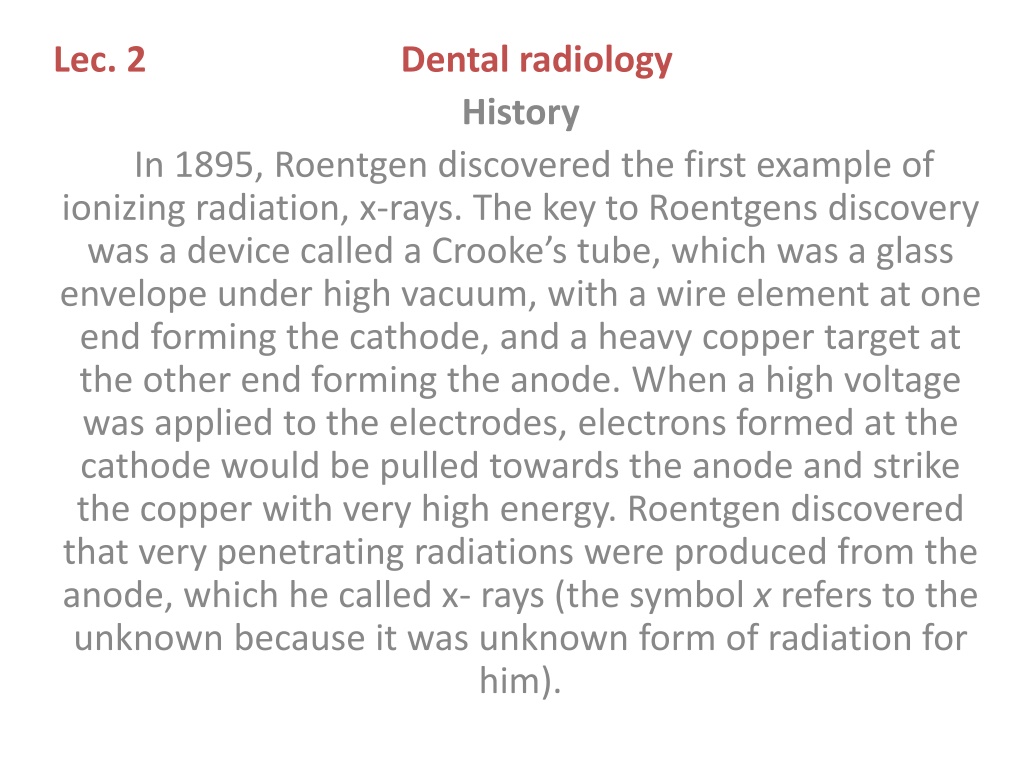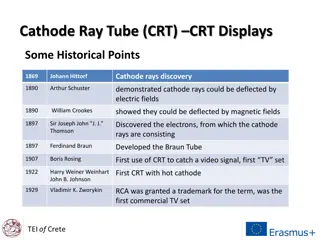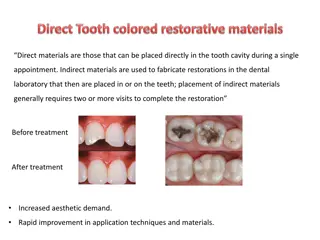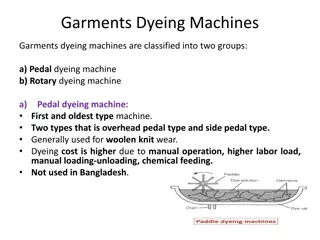Evolution of Dental Radiology: From Roentgen's Discovery to Modern X-ray Machines
In 1895, Roentgen discovered x-rays using a Crooke's tube, marking the beginning of dental radiology. This technology evolved over time, leading to the development of modern dental x-ray machines with control panels and specialized parts like the tube head and extension arm. The components such as the metal housing and insulating oil play crucial roles in ensuring safety and efficiency during x-ray procedures.
Download Presentation

Please find below an Image/Link to download the presentation.
The content on the website is provided AS IS for your information and personal use only. It may not be sold, licensed, or shared on other websites without obtaining consent from the author. Download presentation by click this link. If you encounter any issues during the download, it is possible that the publisher has removed the file from their server.
E N D
Presentation Transcript
Lec. 2 Dental radiology History In 1895, Roentgen discovered the first example of ionizing radiation, x-rays. The key to Roentgens discovery was a device called a Crooke s tube, which was a glass envelope under high vacuum, with a wire element at one end forming the cathode, and a heavy copper target at the other end forming the anode. When a high voltage was applied to the electrodes, electrons formed at the cathode would be pulled towards the anode and strike the copper with very high energy. Roentgen discovered that very penetrating radiations were produced from the anode, which he called x- rays (the symbol x refers to the unknown because it was unknown form of radiation for him).
Typical dental x-ray machine parts: 1-Control panel with regulating devices 2-Extension arm or bracket enabling tube head to be positioned 3-Tube head containing x-ray tube from which x-rays are generated
Control panel in Dental X-ray Machine hasFive major controls: Line switch Milliampere (mA) selector Kilovolt peak (kVp) selector Timer Exposure button
2-Extension arm: the wall-mounted extension arm suspends the x-ray tubehead and houses the electrical wires that extend from the control panel to the tubehead. 3- Tubehead: is a tightly sealed, heavy metal housing that contains the x-ray tube that produces x-rays. Parts of tubehead include:
-Metal housing: The x-ray tube housing provides several functions in addition to enclosing and supporting the other components. It functions as a shield and absorbs radiation, except for the radiation that passes through the window as the useful x-ray beam. Its relatively large exterior surface dissipates most of the heat created within the tube. It is filled with insulating oil. -Insulating oil: The space between the housing and insert is filled with oil, it surrounds the x-ray tube and transformers and provides electrical insulation and transfers heat from the insert to the housing surface. -Tubehead seal:Or the aluminum or lead-glass covering of the tubehead that permits the exit of x-ray from the tubehead; it seals the oil in the tubehead and acts as a filter to the x-ray beam.
X-Ray Tube: - vacuum Protection housing Projectile electron
-X-ray tube: Or the heart of x-ray generating system. -Transformer: Is a device thatalters the incoming electricity. three types: a. step-down: is used to decrease the voltage from the incoming 110 or 220 volts to 3 to 5 volts required b. step-up: is used to increase the voltage from the incoming 110 or 220 line voltage to the 65000 to 100 000 volts required. c. auto transformer: serves as a voltage compensator that correct for minor fluctuations in the current. -Filters aluminum sheets used to remove or filter out the longer, useless x-rays total filtration = inherent plus added 1.5 mm. aluminum 69 or lower kVp 2.5 mm. aluminum 70 or higher kVp
Inherent filtration: include the glass window of the x-ray tube, the insulating oil, and the tubehead seal . Inherent filtration is equivalent to approximately 0.5 to 2.0 millimeter of aluminum. Added filtration: refers to the placement of aluminum disks in the path of the x-ray beam between the collimator and the tubehead seal in the dental x-ray machine. The aluminum disks can be added in 0.5mm increments. The purpose of aluminum disks is to filter out the longer wavelength, low-energy x-rays from the x-ray beam. -Collimator lead diaphragm controls size and shape of x-rays A rectangular collimator restricts the size of x-ray beam to an area slightly larger than a size 2 intraoral film and significantly reduces patient exposure; while circular collimator produces a cone-shaped beam that is 2.75 inches in diameter (considerably larger than size 2 intraoral film) -Position indicating device (PID): open-ended, lead lined cylinder that extends from the opening of the metal housing of the tubehead; it aims and shapes the x-ray beam. The PID is sometimes referred to as the cone.
THE X-RAY TUBE Function An x-ray tube is an energy converter. It receives electrical energy and converts it into two other forms: x- radiation and heat. The heat is an undesirable byproduct. X-ray tubes are designed and constructed to maximize x- ray production and to dissipate heat as rapidly as possible. The x-ray tube is a relatively simple electrical device typically containing two principle elements: a cathode and an anode. As the electrical current flows through the tube from cathode to anode, the electrons undergo an energy loss, which results in the generation of x- radiation.
Cathode The basic function of the cathode is to expel the electrons from the electrical circuit and focus them into a well-defined beam aimed at the anode. The typical cathode consists of a small coil of wire (a filament) recessed within a cup-shaped region. Electrons that flow through electrical circuits cannot generally escape from the conductor material and move into free space. They can, however, if they are given sufficient energy. In a process known as thermionic emission, thermal energy (or heat) is used to expel the electrons from the cathode. The filament of the cathode is heated in the same way as a light bulb filament by passing a current through it. During tube operation, the cathode is heated to a glowing temperature, and the heat energy expels some of the electrons from the cathode.
Focusing cup Filament tungsten side view (cross-section front view (facing target)
Hot filament
Anode The anode is the component in which the x-radiation is produced. It is a relatively large piece of metal that connects to the positive side of the electrical circuit. The anode has two primary functions: (1) To convert electronic energy into x-radiation, and (2) To dissipate the heat created in the process. The material for the anode is selected to enhance these functions. The ideal situation would be if most of the electrons created x-ray photons rather than heat. The fraction of the total electronic energy that is converted into x-radiation (efficiency) depends on two factors: (1) The atomic number (Z) of the anode material and (2) The energy of the electrons. Most x-ray tubes use tungsten, which has an atomic number of (74), as the anode material.
Target Copper stem
Causes of using tungsten as anode material: 1- A high atomic number. 2-Tungsten is almost unique in its ability to maintain its strength at high temperatures. 3- A high melting point 4-A relatively low rate of evaporation. For many years, pure tungsten was used as the anode material. In recent years an alloy of tungsten and rhenium has been used as the target material but only for the surface of some anodes. The use of a rhenium-tungsten alloy improves the long-term radiation output of tubes. With x-ray tubes with pure tungsten anodes, radiation output is reduced with usage because of thermal damage to the surface. Most anodes are shaped as beveled disks and attached to the shaft of an electric motor that rotates them at relatively high speeds during the x-ray production process. The purpose of anode rotation is to dissipate heat.
Focal Spot Not all the anode is involved in x-ray production. The radiation is produced in a very small area on the surface of the anode known as the focal spot. The dimensions of the focal spot are determined by the dimensions of the electron beam arriving from the cathode. In most x-ray tubes, the focal spot is approximately rectangular. The dimensions of focal spots usually range from 0.1 mm to 2 mm. X-ray tubes are designed to have specific focal spot sizes; small focal spots produce less blurring and better visibility of detail, and large focal spots have a greater heat-dissipating capacity.
3-X-ray generating apparatus. Electricity: is the energy that is used to make x-rays, electrical energy consists of a flow of electrons through a conductor; this flow is known as the electrical current. -Direct current (DC): When electrons flow in one direction through the conductor. -Alternating current: when electrons flow in two opposite directions. -Rectification: The conversion of alternating current to direct current. milliamperage control heats cathode filament and determines number of electrons 1 mA = 1/1000 ampere Ampere = unit of electrical current measurement - High Voltage potential to accelerate electrons across the tube voltage = electrical potential (pressure) volt = unit of measurement kVp = kilovolt peak control (1,000 volts = 1 kilovolt) kVp regulates electrical potential greater kVp, the greater speed of electrons -
The filament circuit uses 3 to 5 volts, regulate the flow of electrical current to the filament of the x-ray tube and is controlled by the milliampere settings( depending on the step-down transformer action). -The high voltage ciecuit uses 65000 to 100000 volts, provides the high voltage required to accelerate the electrons and to generate x-ray in the x-ray tube, and is controlled by the kilovoltage settings( depending on the action of step-up transformer). Duty Cycle: The duty cycle is how long each exposure will be and how long will be given in between exposures for cooling. If a unit will be operated continuously, with no cooling intervals, this is termed continuous duty.

















































